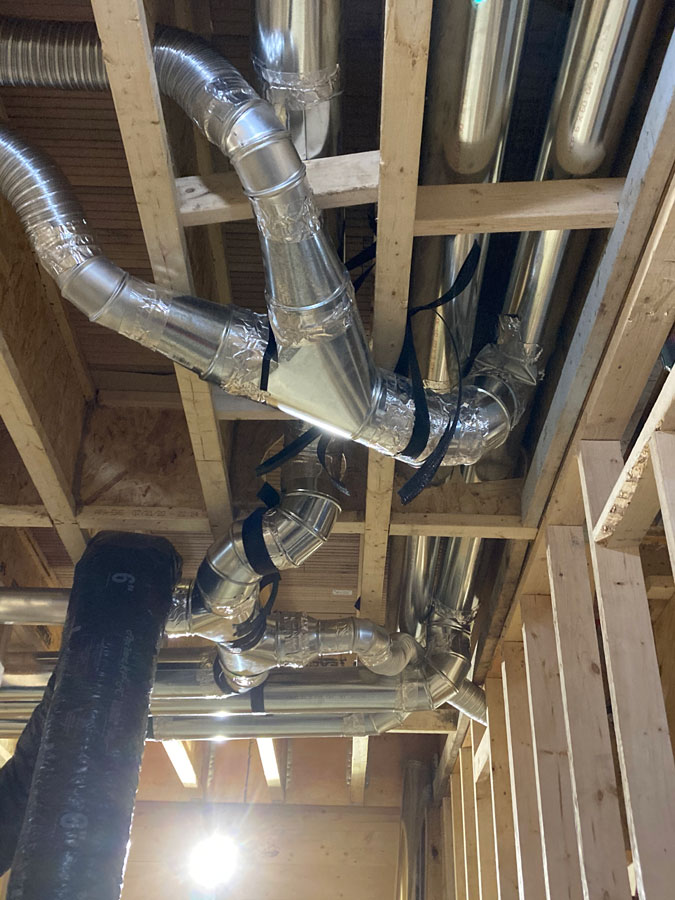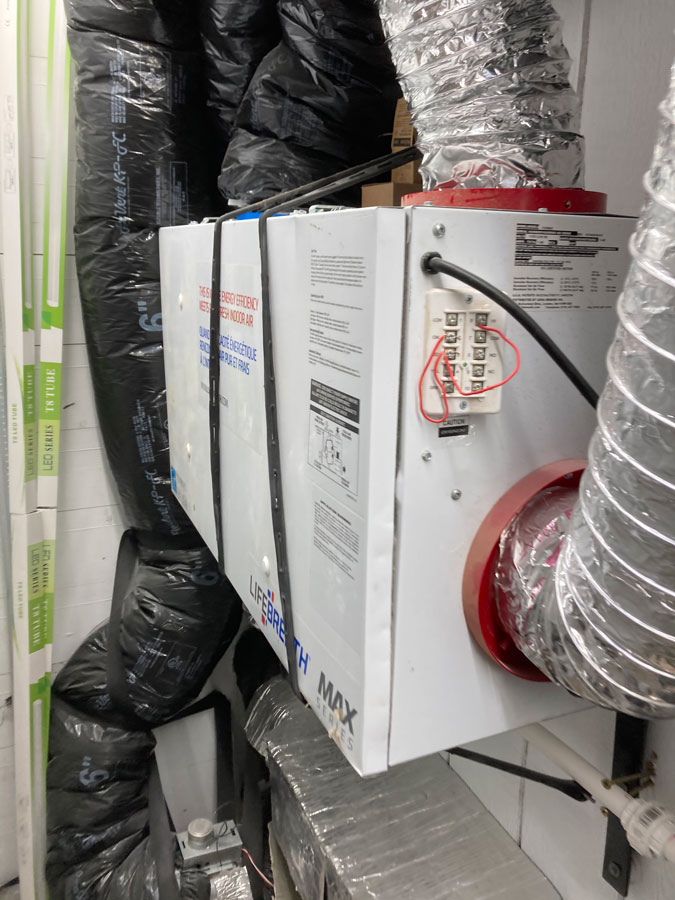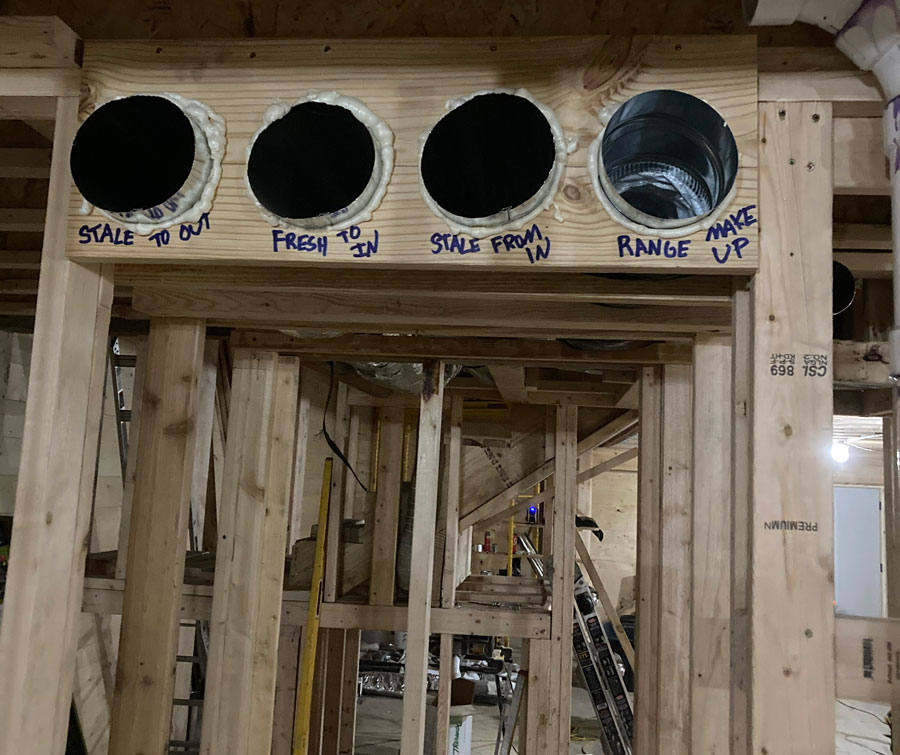The extremely tight envelope of my home is designed to prevent air from leaking in or out. That’s why I installed an HRV system to mechanically send stale air out and bring fresh air in.
When I tell people about my continuous insulation and air tight home design, I often hear, “but the house needs to breathe”. I don’t disagree – airflow is important. That said, I want to be in control of what’s coming in and out. That’s why I installed an HRV system.
What is an HRV System?
HRV stands for Heat Recovery Ventilation, and HRV systems are designed to help with airflow in residential and commercial buildings. These systems have two ducts – one that gets rid of the stale air, and another one that brings in fresh air from outside. Even though these two airstreams don’t touch, there is a heat exchanger that allows the air going out to help warm any cool air coming in. In fact, most HRVs are roughly 80% efficient in exchanging heat from the outgoing to incoming air. This allows for nicely conditioned fresh air to enter the space.
Why Do I Need an HRV System in My Home?
Traditional homes rely on involuntary air “leaks” through windows, doors and walls to ventilate naturally. Because I’m building my house to be extremely well insulated and air tight, I don’t expect to have air freely flowing in and out. For that reason, I needed to find a way to mechanically ventilate it on my own terms. That’s where the HRV comes in.
I have set up my system to pull air out of the bathrooms, laundry room and kitchen, as these are areas of the home that could get stuffy or produce moisture, and should be exhausted. I am then pumping fresh air into all of the bedrooms. CO2 levels can get high in bedrooms at night when people are sleeping, so fresh air is needed.

What About Bathroom Exhaust Fans?
My HRV eliminates the need to have fart exhaust fans in the bathrooms. Because the HRV is running continuously, it doesn’t need to be turned on for smelly bathroom situations or steamy showers. It’s already taken care of!
Additionally, exhaust fans require penetrations in the walls or ceiling to be able to vent. As you know from my previous post on insulation, I want to eliminate any penetrations in my building envelope that are not 100% necessary. Utilizing an HRV system instead of bathroom fans allows me to do that.
What About Range Hood Exhaust?
We are planning to install a range hood to suck out kitchen fumes. Our range hood pulls less than 400 CFM, so it technically doesn’t require make-up air per code. That said, in order to send air out, we need to have air to send. (And we don’t necessarily have this naturally because our house is so air tight.)
We can’t utilize the HRV system to supply this air because it’s a balanced system. So in order to have proper ventilation, I am directing make-up air through an insulated 6” duct to the range itself. When the range hood turns on, a damper will automatically open. When the range hood is running, it will pull the fumes from the range, while also pulling make-up air, and sends them both outside.
Should the Incoming Air Be Filtered?
I have two 6” holes on the side of the house for incoming air – one for the HRV and one for the range hood make-up air. I wanted to ensure the air coming in through the HRV system is clean and healthy, so I opted to add a FB6 In-Line Filter Box with MERV 13 Filter. When the air comes in from outside, before it hits the HRV system, it goes through this filter. This should remove any dust or pollen. Because the incoming make-up air for the range hood is getting sucked right back outside, I didn’t see a need to filter it.
Selecting an HRV System
I’m going to be honest – I didn’t do a whole ton of research on which HRV I wanted to buy. When I was shopping at Habitat for Humanity ReStore in Columbus, Ohio and saw an HRV system for $50, I knew it was the one. I looked up the Lifebreath 195DCS Residential Heat Recovery Ventilator and saw that it would fit my needs, so I snatched it up as fast as I could! (This is a $900 system when purchased new.) It might be held together with some bungee cords in my mechanical closet, but she works like a charm.

Do You Need an HRV System in Your Home?
If you live in a traditionally-built home, you probably don’t need an HRV system. You could certainly install one to help with healthy airflow if you felt so inclined, but your house probably “breathes” enough naturally that you can live without. If you’re embarking on a new build with an air tight enclosure, you better snatch one of these puppies up. Keep your air flowing and healthy with an HRV system.
And as always, build on!

